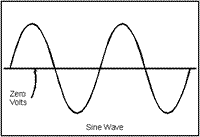|
An electric guitar cannot be heard to well without an amplifier. This is a vacuum tube guitar amplifier, very simple amp. Most amps will have equalization knobs such as bass, midrange, and treble, this amp only has volume and tone. Vacuum tubes are becoming very obsolete and not very practical since the modern transistor could be used to amplify a signal. The disadvantage to a transistor based amplifier is that they sharply clip when the signal is pushed too far and creates distortion, which could wear out a speaker rather quickly. Vacuum tube amps are used worldwide on countless stages. These two vacuum tubes are readily available to buy. They are very expensive compared to a transistor to the same specification. The tube on the left is called a preamp tube, it helps amplify the weak signal coming from the guitar; these tubes cost in the range of $10 to $25. This tube only pushes the signal up to two watts. This is where another amplifier stage is needed. The tube on the right is called a power-amp tube and it cost in the same range of a preamp tube. It helps boost the preamp signal up to 15 watts with this amp. There is a big difference in sounds between a tube amp and a solid state amp. Vacuum tube amps have “warmth” that solid state does not have. Thus many solid state amps are much lower in price compared to tube amps. This amp shown currently costs about $300, compared to a similar 15 watt solid state amp costing around $120. One may think that 15 watt amps solid state or tube would maintain the same volumes. This is not exactly true; a tube amp seems VERY loud compared to the solid-state counterpart. This is due to harmonics that tubes create which make the amp seem much louder. There is not much parts needed to make an amp, many of the earliest amps were based from radio circuits. This picture above looks really complicated, but it is not. After the guitar signal is amplified into a much larger signal or current, it is then looped into the speaker which acts as a small resistor, so with different speakers an amp could be pushed past its power rating. The speaker illustrated below shows how he signal is converted into sound.
flash animation from howstuffworks.com Another form of an amplifier is effects.
Effects are usually connected between the guitar and amp; sometimes amps will have a connection to effects separate from the guitar input called an effects loop. An effects loop usually loops the preamp stage of an amp to the input of the effects unit, and then sends it to the power-amp section. The unit on the left is called a multiprocessor. It has many different effects like distortion (not bad distortion from solid state amps), or other clean sounding patches. The effect on the right is called an overdrive, it simulates a tube amp when overdriven. Many of the guitar solos on records are recorded through a unit like on the right.
images from R.G. Keen The sine wave on the left shows how a clean amplified signal appears. The middle wave shows how a distorted guitar signal appears. The right wave is how tube amps distort. The guitar effects pedal on the left generally produces the middle wave, and the pedal on the right produces more of the right "tube-ish distortion" wave. |
||||
|


